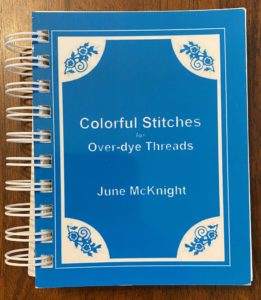
Colorful Stitches with Overdyed Threads, June McKnight, 2010, self-published.
Updated April 12, 2021. I am overwhelmed with major deadlines this week, including half a 700= page book to finish. Therefore, no new posts from me today or Thursday. Instead, find updates of older articles.
I am of two minds about this book. There is lots I like about it, but I think it has some flaws.
Overdyed and hand-dyed threads have, in many ways, revolutionized the needlepoint world over to last 30+ years. Even so, stitchers struggle with how to use them, how they look when stitched and they worry if the results will look good. We also find ourselves wondering about how the threads are created.
Clearly, there is a need for books dealing with these threads.
June has done a marvelous job of telling us about the threads. At the beginning of the book, she covers basic information about fibers and the different types of threads. One wonderful aspect of this that is rarely discussed is the disadvantages of each type of thread. Her experience as a teacher and shopowner comes to bear in giving us advice on using each type of thread.
Next, she has a long section on dyeing. Since dyeing threads is confusing and terms aren’t standardized, she has a glossary of terms and talks about the challenges of dyeing each type of fiber. She also shows a picture of the same shade across Caron’s threads, so you can see how each fiber reacts differently to the dye. Then she shows some wonderful behind-the-scenes pictures of the process at Caron. Both June and the company are to be commended for providing us with this look.
Then she talks briefly about how skeins can be assembled. This is important because it can affect your stitching. Knowing how a particular company’s skeins are assembled allows you to pick the thread for a particular purpose or to color match easily. This section ends with helpful hints and a listing of many companies making overdyed threads.
The remaining 2/3 of the book deals with stitches. Each stitch has two pages. On the left is a color picture of the stitch. Under the picture is the name and color of the thread. On the right is a large diagram of the stitch with some tips under it. Stitches are grouped into sections by type: Satin, Upright, Cross, Leaf, and Compound.
I’m not happy with the classification here, nor with many of the stitches. While there are many delightful stitches here, it’s hard to tell what’s what. There are compound stitches found in the other chapters, many different techniques are grouped into each section and open and non-open stitches are grouped together. As near as I can tell “Satin Stitches” means at least some part of the stitch is a diagonal stitch over more than one thread, even though usually “Satin Stitch” refers to a straight stitch. “Upright” means that at least one part of the stitch has a straight stitch. And so on. Looking at the stitches in the book, I see stitches that could go in several different chapters, this limits the usefulness of the book. With fewer than 50 stitches, couldn’t they been put in alphabetical order, this would have made them easier to find.
I’m also disappointed with the lack of text for most stitches. in the section on stitches, terms are not explained, but are left for the stitcher to figure out with the diagrams. While I see many stitches that are intriguing, I have no idea where or how I would use them. I’m left feeling as if I should have gotten more out of the book.
June is a great teacher and has forgotten more about needlepoint than most of us will ever know, but I sure do wish her books gave us a better idea of her knowledge. I am delighted to learn about the threads, but, I think the overall usefulness of the book is hampered by poor organization and too little in the way of stitches. It’s not a good value for the money.
The FTC requires me to disclose if I was given the book for purposes of review. I wasn’t, this book was bought at retail.
About Janet M Perry
Janet Perry is the Internet's leading authority on needlepoint. She designs, teaches and writes, getting raves from her fans for her innovative techniques, extensive knowledge and generous teaching style. A leading writer of stitch guides, she blogs here and lives on an island in the northeast corner of the SF Bay with her family

Leave a Reply